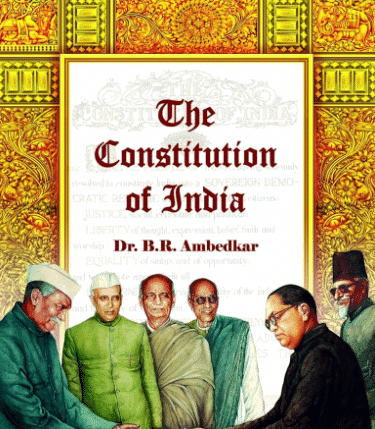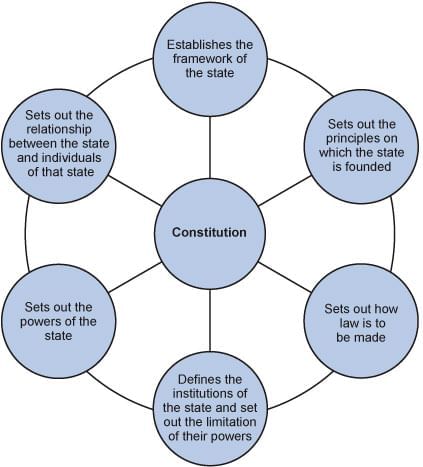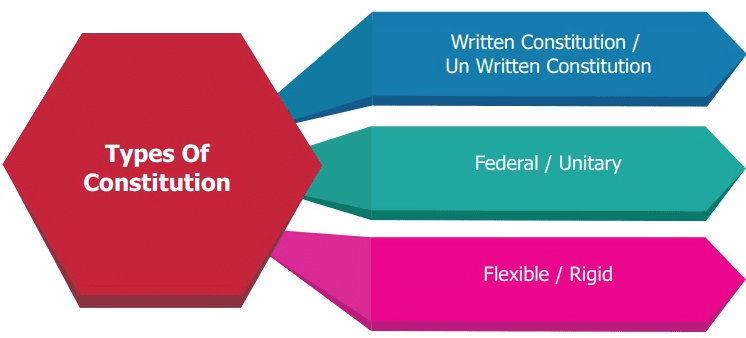Meaning & Definition of Constitution | Constitutional Law - CLAT PG PDF Download
Introduction
- A constitution is essential for the governance of any country, whether democratic or authoritarian.
- Historically, rules and regulations have been necessary to maintain order and harmony within societies.
- The constitution outlines the roles and organization of political institutions, preventing societal chaos.
- In modern states, these foundational rules are encapsulated in a written constitution.

Meaning of a Constitution
A Constitution is the foundational law of a country that defines the structure, powers, and responsibilities of the government while ensuring the rights and welfare of citizens. It acts as a guiding document that shapes the nation’s governance and reflects its ideals.
Key aspects of a Constitution’s meaning include:
- Creates and Organizes Government Institutions:It sets up the main branches of government, such as the legislature (law-making body), executive (law-enforcing body), and judiciary (law-interpreting body), and explains how they work together.
Example: The Indian Constitution establishes the Parliament (Lok Sabha and Rajya Sabha), the Prime Minister’s office, and the Supreme Court as key institutions.
- Distributes Powers (in Federal Systems):In countries with a federal system (like India or the USA), the Constitution divides powers between the central (union) government and state governments to ensure smooth governance.
Example: In India, the Constitution’s Seventh Schedule lists powers: the Union handles defense and foreign affairs, while states manage education and public health.
- Protects Citizens’ Rights and Promotes Welfare: A Constitution guarantees fundamental rights, such as freedom, equality, and justice, and often includes provisions to promote the well-being of citizens through social, economic, and political measures.
Example: The Indian Constitution’s Fundamental Rights (Articles 12–35) ensure rights like equality before the law, while Directive Principles promote welfare through policies like free education.
- Reflects a Nation’s Values and Aspirations: A Constitution embodies the ideals and goals of a country, such as justice, liberty, equality, or fraternity, serving as a reflection of its identity and vision for the future.
Example: The Preamble of the Indian Constitution declares India as a sovereign, socialist, secular, democratic republic, aiming for justice, liberty, equality, and fraternity.
In essence, a Constitution is like a rulebook that organizes the government, protects the people, and expresses what the nation sta
Definitions of a Constitution
Experts and scholars have described a Constitution in different ways to highlight its role in governance. Here are three key definitions:
- K.C. Wheare: “The whole system of government of a country, the collection of rules which establish and regulate or govern the government.”
- C.F. Strong: “A collection of principles according to which the powers of the government, the rights of the governed, and the relations between the two are adjusted.”
- Aristotle: The organization of a state’s offices and institutions.
- Bryce: A constitution is the aggregate of laws and customs governing the state.
- Herman Finer: The constitution embodies power relationships and political institutions.
- Austin: A constitution fixes the structure of supreme government.
These definitions show that a Constitution is both a legal document and a system of principles that shapes how a country is governed.
Key Characteristics of a Constitution
 A Constitution has unique features that make it the cornerstone of a country’s legal system. These are:
A Constitution has unique features that make it the cornerstone of a country’s legal system. These are:
- Supreme Law of the Land: A Constitution is the highest law in a country. No other law, rule, or regulation can contradict it. If there’s a conflict, the Constitution always wins.
Example: If a new law in India violates the Indian Constitution, the Supreme Court can strike it down because the Constitution is supreme.
- Source of All Legal Authority (Grundnorm): The Constitution is the foundation of all laws in a country. It’s called the “grundnorm” (a term coined by legal scholar Hans Kelsen), meaning the basic norm from which all other laws get their validity.
Example: In the UK, Parliament’s authority to make laws comes from the unwritten Constitution, which includes historical documents like the Magna Carta.
- Balances State Power and Individual Rights: A Constitution ensures the government has enough power to govern effectively but prevents it from becoming too powerful. It protects citizens’ rights, like freedom, equality, and justice, while defining their duties, like paying taxes or obeying laws.
Example: The South African Constitution guarantees rights like freedom of expression but also allows the government to limit these rights in certain cases, like to maintain public safety.
Functions of a Constitution
A Constitution serves several critical purposes in a country:
- Establishes Government Structure: It defines the branches of government (e.g., legislature to make laws, executive to enforce laws, judiciary to interpret laws) and how they interact.
- Defines Powers and Limits: It explains what each branch of government can do and sets boundaries to prevent abuse of power.
- Protects Citizens’ Rights: It lists fundamental rights, like the right to life, equality, or freedom of religion, and ensures the government respects them.
- Provides Stability and Order: By setting clear rules, a Constitution creates a stable framework for governance and reduces conflicts.
- Guides Law-Making: All laws must align with the Constitution, ensuring consistency in the legal system.
Example: The Indian Constitution outlines the roles of the Parliament, Prime Minister, and Supreme Court, while also guaranteeing rights like equality before the law (Article 14).
Why is a Constitution Important?
A Constitution is like the heart of a country’s legal and political system. Its importance lies in:
- Ensuring Fair Governance: It prevents the government from becoming authoritarian by setting limits on its power.
- Protecting Rights: It safeguards citizens from injustice and ensures they have freedoms like speech, religion, and equality.
- Promoting Unity: By providing a shared set of rules, it unites diverse groups in a country under one system.
- Guiding Future Generations: A Constitution is a long-lasting document that shapes a country’s future.
Example: The Constitution of Japan, enacted in 1947, promotes peace and democracy, guiding the country’s policies even today.
Types of Constitutions
A Constitution is the supreme law that defines how a country is governed. However, not all Constitutions are the same. They vary based on how they are documented, how easily they can be changed, and how power is distributed within the country. These notes explain the different types of Constitutions in simple and detailed language, with examples and a focus on the Indian Constitution.
1. Written vs. Unwritten Constitutions
Constitutions can be classified based on whether they are codified in a single document or based on a collection of laws and traditions.
- Written Constitution: A written Constitution is codified in a single, formal document that outlines the structure of the government, its powers, and the rights of citizens. It is clear, organized, and serves as a single reference point for all laws.
Example: The Indian Constitution, adopted in 1950, is a written document that details the structure of the government, fundamental rights, and directive principles in one comprehensive text.
- Unwritten Constitution: An unwritten Constitution is not contained in a single document. Instead, it is based on a collection of statutes, conventions, judicial decisions, and historical traditions that together form the framework of governance.
Example: The UK Constitution is unwritten, relying on documents like the Magna Carta (1215), the Bill of Rights (1689), and unwritten conventions, such as the role of the Prime Minister.
Note: Written Constitutions are more common in modern nations because they provide clarity and a single source of authority. Unwritten Constitutions are flexible but can be less clear.
2. Rigid vs. Flexible Constitutions
Constitutions can also be classified based on how difficult or easy it is to amend (change) them.
- Rigid Constitution: A rigid Constitution requires special procedures, such as a supermajority (e.g., two-thirds vote) or approval by multiple authorities, to make amendments. This ensures the Constitution remains stable and is not changed轻易.
Example: The Indian Constitution is largely rigid. Under Article 368, amendments require a two-thirds majority in both houses of Parliament, and some changes need approval from at least half of the state legislatures.
- Flexible Constitution: A flexible Constitution can be amended through the same process as ordinary laws, making changes easier and quicker. This allows the Constitution to adapt to changing times but may lead to instability.
Example: The UK Constitution is flexible because it is unwritten and based on statutes and conventions. Parliament can change constitutional laws with a simple majority, as it did with the Parliament Acts of 1911 and 1949.
Note: Rigid Constitutions protect fundamental principles but may be slow to adapt. Flexible Constitutions are adaptable but risk frequent or hasty changes.
3. Federal vs. Unitary Constitutions
Constitutions can be classified based on how power is distributed between the central government and regional (state or local) governments.
- Federal Constitution: A federal Constitution divides power between the central (national) government and regional (state or provincial) governments. Each level has its own responsibilities, and neither can fully control the other.
Example: The Indian Constitution is federal, dividing powers between the Union (central government) and states. The Union List includes defense and foreign affairs, while the State List includes education and public health.
- Unitary Constitution: A unitary Constitution centralizes power in the national government, with regional or local governments having only the powers delegated to them by the center. This creates a more unified system but less regional autonomy.
Example: The UK Constitution is unitary. The UK Parliament in Westminster holds supreme authority, and devolved governments in Scotland, Wales, and Northern Ireland have limited powers granted by Parliament.
Note: Federal Constitutions suit diverse or large countries, allowing regional autonomy. Unitary Constitutions are simpler and suit smaller or less diverse nations.
4. The Indian Constitution: A Special Case
The Indian Constitution is a unique blend of different types, combining features to suit India’s diverse and complex needs.
- Written: The Indian Constitution is a single, codified document, one of the longest in the world, with 470 articles and 12 schedules (as of 2025).
- Largely Rigid: It is primarily rigid, requiring a two-thirds majority in Parliament for most amendments (Article 368). However, some parts, like administrative changes, are more flexible and can be amended with a simple majority.
- Federal with Unitary Features: India has a federal structure, with powers divided between the Union and states. However, it has unitary features, such as a strong central authority during emergencies (Article 356) and a single Constitution for the entire country.
Example: The Indian Constitution’s federal nature is seen in the division of powers (Union, State, and Concurrent Lists), while its unitary feature is evident in the President’s power to impose President’s Rule in a state during a crisis.
Note: The Indian Constitution is often described as a “federal structure with a unitary bias” because it balances regional autonomy with a strong central authority to maintain national unity.
Why Understanding Types of Constitutions Matters
Knowing the types of Constitutions helps us understand:
- Governance Styles: How different countries organize their governments and balance power.
- Adaptability: Whether a Constitution can easily respond to changing needs or remains stable over time.
- Power Distribution: How power is shared between central and regional governments, affecting local autonomy and national unity.
- National Context: Why a country chooses a particular type of Constitution based on its history, diversity, and needs.
Example: India’s written, rigid, and federal Constitution suits its diverse population and vast size, while the UK’s unwritten, flexible, and unitary Constitution fits its smaller, more centralized system.
Conclusion
A Constitution is essential for any country as it serves as the fundamental legal framework that governs how a nation operates. It outlines the structure and powers of the government while safeguarding the rights and freedoms of its citizens. By providing clear guidelines, a Constitution helps ensure fair governance and protects individuals from abuses of power.
Different types of Constitutions, such as written vs. unwritten, rigid vs. flexible, and federal vs. unitary, reflect the diverse needs of nations. For instance, the Indian Constitution is a written, largely rigid, and federal document, designed to accommodate India's vast diversity. Understanding these types is crucial as they influence how power is distributed and how responsive a Constitution is to the changing needs of society.
In summary, a Constitution is not just a set of rules; it embodies a nation's values and aspirations, guiding its future and uniting its people under a common legal framework.
|
118 docs|26 tests
|
FAQs on Meaning & Definition of Constitution - Constitutional Law - CLAT PG
| 1. What is the meaning of Constitution? |  |
| 2. How is a Constitution defined in the context of CLAT PG exam? |  |
| 3. Why is the study of Constitution important for CLAT PG preparation? |  |
| 4. What are some key topics related to the Constitution that are commonly asked in the CLAT PG exam? |  |
| 5. How can aspirants effectively prepare for the Constitution section in the CLAT PG exam? |  |
















